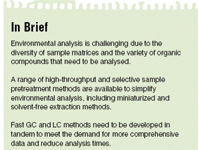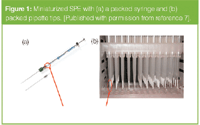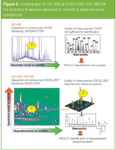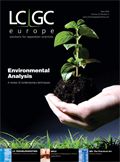Novel Sample Extraction and Chromatographic Techniques in Environmental Analysis
LCGC Europe
An overview of contemporary techniques in environmental analysis.
Analysis of environmental samples is always challenging due to the diversity of sample matrices and the variety of organic species that need to be determined — often in trace amounts. Levels of persistent organic pollutants (POPs), radionuclides and toxic metals have been extensively measured in various parts of the environment. POPs include industrial compounds and flame-retardants, such as polychlorinated biphenyls (PBPs), polychlorinated naphthalenes (PCNs), polybrominated diphenyl ethers (PBDEs), polybrominated biphenyls (PBBs); industrial by-products, such as polychlorinated dibenzo-p-dioxins (PCDDs) and polychlorinated dibenzofurans (PCDFs); and organochlorine (OC) pesticides. More recently, the emphasis has been placed on determining levels of emerging contaminants, such as surfactants, human and veterinary drugs, fragrances, antiseptics, new brominated/chlorinated flame retardants, sunscreens/UV filters, contaminant dibutylphthalates (DBPs), benzotriazoles, naphthenic acids, perfluorinated surfactants, pesticide degradation products, chiral contaminants and microorganisms.1,2
Many laboratories still use conventional methods to analyse environmental samples. These are often time-consuming, labour-intensive and poorly suited for analysing large volumes of samples. Additionally, the sensitivity, selectivity and reliability of many conventional multi-step procedures are not satisfactory. Improvements in the whole analysis — from sample pre-treatment to final analysis — is, therefore, essential for environmental analysis to evolve. Recent developments in this field include miniaturized and (nearly) solvent-free extraction techniques, faster separation methods and more efficient separation by comprehensive two-dimensional (2D) techniques. It should be noted that there is no practical use of applying fast gas or liquid chromatographic (GC and LC) methods if sample preparation still takes several hours — or even days. Thus, fast sample preparation methods, or methods that allow automated sample pretreatment of large volumes of parallel samples are required. It should also be noted that different methods are needed for target-compound analysis and more comprehensive profiling of the samples. The traditional target-compound analysis is more straightforward; however, this type of approach is often insufficient to assess the environmental relevance of emerging contaminants.

In Brief
Novel Approaches in Sample Pretreatment
Recently, there has been a lot of effort put into developing more efficient extraction methods that could replace laborious and time-consuming procedures. For target-compound analysis, selectivity of the sample preparation is often one of the key features in the selection, while for profiling an exhaustive extraction method is a better choice. The clean-up required before the final analysis is also important: fast extraction is not very useful if the extract requires a multi-step and time-consuming clean-up process. Furthermore, the cost of equipment, operating costs, complexity of method development, the amount of organic solvent used and the level of automation required are crucial.
Miniaturized Liquid-, Solid- and Sorbent-Phase Extraction
For liquid samples, novel extraction techniques, such as solid-phase microextraction (SPME), stir-bar sorptive extraction (SBSE) and miniaturized solid-phase extraction (SPE) are gaining ground.1–3 Conventional SPE has been adopted for microextraction by the use of well-plates or with minicolumns, or a syringe or pipette tip packed with solid-phase material (MEPS) (Figure 1).1 Also, liquid-phase microextraction (LPME) and membrane-assisted solvent extraction techniques (MASE) have been developed.1,2 These miniaturized techniques are typically nearly solvent-free and are, therefore, more sustainable and easily implemented, and also reduce exposure of the analyst to solvents.

Figure 1: Miniaturized SPE with (a) a packed syringe and (b) packed pipette tips. [Published with permission from reference 7].
SPME, SBSE, LPME and miniaturized SPE all have their own application range and their own advantages and disadvantages as shown in Table 1. SPME and SBSE are typically used in combination with GC analysis because these methods are best suited to volatile and relatively non-polar analytes. LPME and miniaturized SPE can be used for both non-polar and polar compounds, with varying volatility. Unlike SPE, SPME, SBSE, LPME or MASE are not typically exhaustive extraction methods. In SPME, the absolute recovery can be below about 5%. In SBSE even quantitative recoveries can be obtained with sufficiently long extraction times. However, in SPME and SBSE, the low recovery is well compensated by the fact that the whole extract is typically transferred to the final (GC) analysis. Thus, the absolute amount of analytes injected into GC is typically higher than in exhaustive techniques such as SPE. The benefit of LPME, compared with the other techniques, is the simplicity of the system. The main limitation of LPME is the drop stability, which can often lead to poor repeatability. The problems with drop instability can be avoided by using a hollow fibre membrane (HFM) that serves as a support for the extracting solvent, enabling the use of larger volumes of solvent than in LPME. This membrane-assisted solvent extraction can also be performed in a flat-sheet membrane module or in a membrane bag. Also, membrane extraction systems based on closed hollow-fibres are available and they can be used for on-site sampling. The choice of extraction solvent in MASE is less restricted than in LPME. Also polar, ionizable compounds can be extracted with MASE.

Table 1: Comparison of miniaturized extraction techniques for liquid samples.
Typically, similar sensitivities are obtained with SPE and SPME or SBSE for non-polar analytes.1–12 However, for more polar analytes SBSE results in better sensitivity than SPME. SPE is clearly a better option for highly polar analytes and for non-volatile analytes. The main difference in SPME and SBSE is the instrumentation, which is simpler with SPME. Also, the extraction time in SPME is clearly shorter in most cases. In SBSE, extraction can take as long as 12 hours. Naturally, parallel extraction of several samples is possible, with these systems, but fast analysis of a single sample is not possible. One significant advantage of SPME, SBSE and even MASE in environmental analysis is that extractions can be done on-site.1,2 These devices can be easily stored and transported to preserve the integrity of the analytes extracted.
Miniaturized SPE, using MEPS or packed pipette tips is a good alternative to conventional SPE systems and it shares many of the advantages of SPME and SBSE.12 In miniaturized SPE, extraction is fast and exhaustive. With MEPS, on-line connection with LC and GC is possible (the latter with some restrictions), allowing high sensitivity. With packed pipette tips, however, parallel extraction of several samples is easy and optimization of extraction steps is less restricted than with on-line MEPS. However, only a part of the extract is introduced to the chromatograph.
Enhanced methods for solid samples: For solid samples, the selected extraction technique should be essentially exhaustive. Volatile analytes can be extracted by thermal extraction methods using, for example SPME or SBSE, to trap the extracted analytes. For less volatile analytes, enhanced extraction efficiency can be achieved by using microwave-assisted solvent extraction (MASE), sonication-assisted extraction (SAE) or pressurized liquid extraction (PLE).1–3 Also, supercritical fluid extraction (SFE) can be used. Matrix solid-phase dispersion (MPSD) is another feasible technique, particularly suitable for the extraction of semi-solid plant and biological samples.
For the extraction of solid samples, studies comparing the performance of the novel extraction systems are available.1 Slightly different results are obtained, depending on the study. However, in most cases, at optimized conditions PLE, MAE, SAE and SFE give similar, or better, recoveries than conventional Soxhlet methods. Of these techniques, PLE is the most widely used method, particularly for those sample matrices in which the analytes are very tightly bound. It should also be noted that it is possible to combine a clean-up step directly to, for example, PLE or SFE.
In most cases, particularly for solid samples, extracts require clean-up and/or fractionation before the final analysis. Automated or semi-automated LC fractionation by using single column, on columns in series has shown to be an effective system in fractionation of various types of environmental extracts.1,2 The benefit of such a system is that the separation between different compound classes is clearly better and the separation, as well as optimization of the separation, can be monitored with a high performance liquid chromatographer (HPLC) detector. Also, gel permeation chromatography (GPC) is an elegant technique for fast fractionation of the extracts and the method can be easily automated because the same column can be used repeatedly for hundreds of samples.
Combining Extraction and Chromatography
Many of the systems can be integrated as an on-line system, where the whole analytical procedure takes place in a closed, usually automated system. The benefits are the increased sensitivity and reliability because the sample clean-up in an on-line system tends to be more effective. The most common on-line systems are SPE–LC because automated commercial systems are available. Also, SPE–GC is relatively easy to perform. Other extraction techniques used in on-line systems are LLE, SFE, PLE, MAE, SAE and membrane-based sample pretreatment. The various approaches for on-line coupling have been reviewed recently.1
Novel Methods for Separation
Chromatographic methods are the most used methods in environmental analysis. For both LC and GC systems, MS detection is indispensable in the analysis of complex environmental samples. The overall trends in the development of MS detection include an increasing use of time-of-flight mass spectrometer (TOF-MS) and quadrupole TOF-MS (Q-TOF-MS) for structural elucidation and compound confirmation. These techniques allow precise assessment of empirical formulas to unknowns and provide added confidence for positive identifications in quantitative work.
More Speed for Target Compound Analysis
The speed is crucial particularly when the number of samples is high, or when comprehensive profiling of chemical composition of a single sample is required with one-dimensional (1D) chromatographic methods. In the latter case, careful clean-up and fractionation is required before the chromatographic analyses of the fractions. The speed of the analysis in both HPLC and GC can be improved substantially without sacrificing the separation efficiency or sensitivity.
In GC, the speed of analysis can be enhanced using fast GC approaches. In most cases, just decreasing the length and internal diameter (i.d.) of the column and using a faster temperature ramp will reduce the analysis time substantially without any significant loss of separation efficiency. For example, by decreasing the column dimensions from 30 m × 0.25 mm i.d. to 12 m × 0.1 mm i.d., the analysis time can be decreased from around 45 min to 15 min while the resolution is essentially the same. Sample throughput is increased from around 25 samples to 70 samples in a 24-hour period. Low-pressure GC can also be used for fast separations.
Fast analyses in HPLC can be obtained by using monolithic supports or, alternatively, relatively short columns packed with very small particles. The main advantage of monolithic columns is their excellent hydrodynamic properties, which reduce backpressure and significantly increase flow-rate. The columns packed with very small particles, however, generally have a very high back-pressure, but the problem can be overcome by using elevated temperatures and/or pump systems capable of very high pressures.
Use of ultra high pressures and/or high temperatures can also be exploited in very efficient liquid chromatographic separations, by increasing the column length substantially. By increasing the temperature, the speed and even the resolution can be improved in most reversed-phase (RP) LC separations. At elevated temperature the solute transfer from the mobile phase to the stationary phase is more efficient. Additionally, decreased solvent viscosity at elevated temperature will lead to lower backpressure. This allows the use of higher flow-rates using standard equipment. Most standard columns can withstand temperatures up to 60 °C, and several novel columns that can be operated at even higher temperatures are commercially available. For example, by increasing the temperature from 40 to 90 °C, the backpressure is reduced substantially and the column length could be increased from 15 to 60 cm (four 15 cm columns coupled in series).1 As a result, significantly higher resolution was obtained in a shorter analysis time.
Profiling of Complex Samples by 2D Chromatographic Techniques
For very complex samples the separation efficiency of 1D chromatographic techniques is often not satisfactory. Comprehensive 2D gas and liquid chromatographic techniques (GC×GC and LC×LC) increase the separation efficiency substantially.1,2 Moreover, the cryogenic modulation typically used in GC×GC results in a 20–50-fold increase in sensitivity compared with conventional 1D GC analysis. The GC×GC system is suitable for relatively non-polar and volatile analytes, while the LC×LC system can also be used in the analysis of polar and non-volatile compounds. Both methods allow separation of a large number of compounds in a single run and thus, they are excellent methods for the profiling-type of analysis. Naturally, the instrumentation is more complex than in conventional chromatographic systems.
Commercial GC×GC systems are available and quantitative analysis can also be done with these automated systems. Combination of GC×GC with TOF-MS provides a superior tool for the analysis of complex environmental samples compared with conventional GC–MS methods (Figure 2). Here, an aerosol sample was analysed with both GC–MS and GC×GC–TOF-MS. As a result of co-eluting non-polar species, reliable identification of the compound of interest was not possible with GC–MS. In a more efficient separation with GC×GC–TOF-MS co-elution was avoided and the identification was straightforward as the spectra was matching closely to that if library spectra.1 Moreover, the sensitivity was clearly better, especially for volatile compounds in GC×GC as a result of cryogenic modulation. The example shows that in the case of a complex aerosol sample, the sensitivity and selectivity of conventional GC–MS was not sufficient to identify compounds present at trace level. By using GC×GC–TOF-MS, both the sensitivity and selectivity were clearly higher, and the identification was easier and more reliable.

Figure 2: Comparison of GCâMS and GCÃGCâTOF-MS for the analysis of aerosol samples to identify a sesquiterpene compound.
The development of columns and instruments allowing very fast LC separations has made it possible to develop highly efficient LC×LC systems although commercial systems are not yet available. LC×LC–MS is a sophisticated tool for identification of unknown compounds. Several problems with LC–MS can be avoided with the LC×LC–MS, namely matrix effects are minimized because the separation is more efficient and the identification is also more reliable. With LC–MS, identification of unknown compounds from their mass spectra alone is typically very challenging, even by MSn. In LC×LC–MS chemical characterization of the analytes based on their location in the 2D retention plane (two different retention times) and their spectra makes the identification more feasible.1
Conclusions
From the sample preparation perspective, the more novel extraction methods, such as SPME, SBSE, miniaturized SPE and LPME systems, can be expected to gain more popularity. For solid- and semi-solid samples, PLE seems to be (slowly) replacing conventional Soxhlet extraction methods, because the extraction is much faster and automated systems can be used. However, the extracts from solid- and semi-solid samples particularly require further purification, and currently the extract clean-up is still usually performed with conventional methods (i.e., using manual column chromatographic approaches). This part of the analytical procedure still requires a lot of research as it is becoming the bottleneck of the analytical scheme. Increasing the speed of analysis is essential when a large number of samples need to be analysed. The development of both fast GC and fast LC methods is, therefore, also essential to reduce the analysis time, along with the development of faster sample preparation methods. It can also be expected that GC×GC and LC×LC methods will be used more widely in the future as the demand for more comprehensive data on environmental samples is required. However, commercial LC×LC instruments need to be developed before this is feasible.
Tuulia Hyötyläinen is adjunct professor at the University of Helsinki and also works as head of research at the Maj and Torr Nessling Foundation. She specializes in the development and construction of multidimensional chromatographic methods and on-line sample pretreatment techniques, particularly for environmental analysis.
References
1. M. Petrovic et al., Anal. Bioanal. Chem., 378, 549 (2004).
2. W. Eljarrat and D. Barcelo, TRAC22, (2003).
3. T. Hyötyläinen and M.-L. Riekkola, Anal. Chim. Acta, 614, 27–37 (2008)
4. E. Baltussen, C.A. Cramers and P. Sandra, Anal. Bioanal. Chem., 373, 3–22 (2002).
5. F. David and P. Sandra, J. Chromatogr A, 1152, 54–69 (2007).
6. F. Monteil-Rivera, C. Beaulieu and J. Hawari, J. Chromatogr. A, 1066, 177–187 (2005).
7. K.E. Rasmussen and S. Pedersen-Biergaard, Trends Anal Chem., 23, 1–10 (2004).
8. J.Å. Jönsson and L. Mathiasson, J. Sep. Sci., 24, 495–507 (2001).
9. P. Popp et al., J. Sep. Sci., 26, 961–967 (2003).
10. C. Basheer et al., J. Chromatogr A, 1139, 157–164 (2007).
11. E.Y. Zeng, D. Tsukada and D.W. Diehl, Environ. Sci. Technol., 38, 5737–5743 (2001).
12. L.G. Blomberg, Anal. Bioanal Chem., available on-line.
13. E. Björklund, T. Nilsson and S. Bøwadt, TRAC, 19, 434–445 (2000).
14. T. Numata et al., Anal. Chem., 75, 1450–1457 (2003).
15. N. Ratola et al., J. Chromatogr. A, 1114, 198–204 (2006).
16. M.E. Hattab et al., J. Chromatogr. A, 1143, 1–7 (2007).
17. F. Destaillats et al., J. Chromatogr. A, 1145, 222–228 (2007).
18. U.Lübcke-von Varel, G. Streck and W. Brack, J. Chromatogr. A, 1185, 31–42 (2008).
19. T.Hyötyläinen, J. Chromatogr. A, 1153, 14–28 (2007).
20. Gerd Vanhoenacker and Pat Sandra, Anal. Bioanal. Chem., 390, 245–248 (2008).
21. M. Adahchour, J. Beens and U.A.Th. Brinkman, J. Chromatogr. A, 1186, 67–108 (2008).
22. J. Pol and T. Hyötyläinen, Anal.Bioanal. Chem., 391, 21–31(2008).
23. M. Kallio et al., J. Chromatogr. A, 1125, 234–243 (2006).
24. M. Kivilompolo and T. Hyötyläinen, J. Chromatogr. A, 1145, 155–164 (2000).

Investigating 3D-Printable Stationary Phases in Liquid Chromatography
May 7th 20253D printing technology has potential in chromatography, but a major challenge is developing materials with both high porosity and robust mechanical properties. Recently, scientists compared the separation performances of eight different 3D printable stationary phases.
Detecting Hyper-Fast Chromatographic Peaks Using Ion Mobility Spectrometry
May 6th 2025Ion mobility spectrometers can detect trace compounds quickly, though they can face various issues with detecting certain peaks. University of Hannover scientists created a new system for resolving hyper-fast gas chromatography (GC) peaks.
Altering Capillary Gas Chromatography Systems Using Silicon Pneumatic Microvalves
May 5th 2025Many multi-column gas chromatography systems use two-position multi-port switching valves, which can suffer from delays in valve switching. Shimadzu researchers aimed to create a new sampling and switching module for these systems.
Characterizing Polyamides Using Reversed-Phase Liquid Chromatography
May 5th 2025Polyamides can be difficult to characterize, despite their use in various aspects of everyday life. Vrije Universiteit Amsterdam researchers hoped to address this using a reversed-phase liquid chromatography (RPLC)-based approach.

.png&w=3840&q=75)

.png&w=3840&q=75)



.png&w=3840&q=75)



.png&w=3840&q=75)










